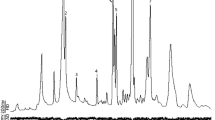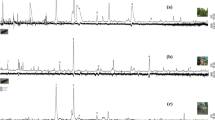Abstract
The secondary screwworm, Cochliomyia macellaria (F.), is an important blowfly species affecting both livestock and humans. It can transmit pathogenic disease agents mechanically and is an agent of facultative myiasis, which leads to economic losses. The adult flies are attracted to decomposing carcasses, carrion, or rotten meat in order to deposit their eggs, and the hatched larvae develop on these decaying organic materials. This research was aimed to identify volatiles emitted from rotten chicken livers that were reported previously to attract gravid females. In laboratory oviposition assays, gravid females laid significantly more eggs on rotten livers than on fresh livers, and rotten chicken liver was more attractive than rotten beef liver. Volatiles from the two livers were collected using solid phase microextraction. Significantly different volatile profiles were detected from the rotten livers of beef and chicken. Electroantennography (EAG) was performed to determine antennal responses to chemicals released from the most attractive chicken liver that are candidate oviposition attractants. Seven compounds from rotten chicken liver elicited significant EAG responses from antennae of gravid females. Oviposition assays showed that the 7-component blend stimulated gravid females to lay significantly more eggs than the other combinations tested. This 7-component blend may have potential for use in monitoring and sampling populations of secondary screwworm and their associated disease epidemiology.





Similar content being viewed by others
References
Anderson GS, Huitson NR (2004) Myiasis in pet animals in British Columbia: the potential of forensic entomology for determining duration of possible neglect. Can Vet J 45:993–998
Bishopp FC (1916) Flytraps and their operation. USDA Farmers’ Bull. No. 734, 14 pp, Washington, D.C.
Bishopp FC (1937) Flytraps and their operation (revised). USDA Farmers’ Bull. No. 734 (rev.), Washington, D.C.
Boatright SA, Tomberlin JK (2010) Effects of temperature and tissue type on the development of Cochliomyia americana (Diptera: Calliphoridae). J Med Entomol 47:917–923
Broce AB (1985) Myiasis-producing flies. In: Williams RE, Hall RD, Broce AB, Scholl PJ (eds) Livestock entomology. Wiley, New York, pp 83–100
Brown HE, Mackley JW (1983) Changes in attractancy and chemical composition of the screwworm chemical attractant, swormlure-2, under field conditions. J Econ Entomol 76:1273–1278
Byrd JH (1998) Temperature dependent development and computer modeling of insect growth: its application to forensic entomology. Ph.D. dissertation, University of Florida, USA
Chaudhury MF, Welch JB, Alvarez LA (2002) Responses of fertile and sterile screwworm (Diptera: Calliphoridae) flies to bovine blood inoculated with bacteria originating from screwworm-infested animal wounds. J Med Entomol 39:130–134
Coppedge JR, Ahrens E, Goodenough JL, Guillot FS, Snow JW (1977) Field comparisons of liver and a new chemical mixture as attractants for the screwworm fly. Environ Entomol 6:66–68
Cork A (1994) Identification of electrophysiologically-active compounds for new world screwworm, Cochliomyia hominivorax, in larval wound fluid. Med Vet Entomol 8:151–159
Cork A, Hall MJR (2007) Development of an odour-baited target for female new world screwworm, Cochliomyia hominivorax: studies with host baits and synthetic would fluids. Med Vet Entomol 21:85–92
Cushing EC, Patton WS (1933) Studies on the higher Diptera of medical and veterinary importance, Cochliomyia americana, sp. nov., the screwworm fly of the New World. Ann Trop Med Parasitol 27:539–551
Deng Y-H, Wu W, Chen Z-Z, Fan Z-D (2009) American secondary screwworm fly, Cochliomyia macellaria (Fabricius, 1775) intercepted from entry cargoes at ports in China (Diptera: Calliphoridae). Acta Parasitol Med Entomol Sin 16:172–176
Guillot FS, Coppedge JR, Goodenough JL, Adams TS, Ahrens E (1977a) Behavior and reproductive status of native female screwworms attracted to a host. Ann Entomol Soc Am 70:588–590
Guillot FS, Coppedge JR, Goodenough JL, Ahrens E, Adams TS (1977b) Reproductive status of female screwworms captured from hosts or in traps. Southwest Entomol 2:49–52
Hall RD, Doisy KE (1993) Length of time after death: Effect on attraction and oviposition or larviposition of midsummer blow flies (Diptera: Calliphoridae) and flesh flies (Diptera: Sarcophagidae) of medicolegal importance in Missouri. Ann Entomol Soc Am 86:589–593
Jones CM, Oehler DD, Snow JW, Grabbe RR (1976) A chemical attractant for screwworm flies. J Econ Entomol 48:459–462
Krafsur ES, Hightower BG, Leira L (1979) A longitudinal study of screwworm populations, Cochliomyia hominivorax (Diptera: Calliphoridae), in northern Veracruz, Mexico. J Med Entomol 16:470–481
Laake EW, Cushing EC (1930) Fly trapping on the ranges of the southwest. J Econ Entomol 42:684–685
Laake EW, Cushing EC, Parish HE (1936) Biology of the primary screw worm fly, Cochliomyia americana and a comparison of its stages with those of C. macellaria. USDA Technical Bull No. 500, 24 pp., Washington, D.C.
Lindquist AW (1938) A study of the incidence and habits of Cochliomyia americana by means of flytraps. J Kans Entomol 11:97–104
Lindquist AW (1954) Flies attracted to decomposing liver in Lake County, California. Pan-Pac Entomol 30:147–152
Mackley JW (1986) Incidence of the screwworm, Cochliomyia hominivorax, and the secondary screwworm, C. macellaria (Diptera: Calliphoridae), in the central highlands of Chiapas, Mexico. J Med Entomol 23:76–82
Mackley JW, Brown HE (1984) Screwworm research 1976–84; attractants, behavior, ecology and control technologies. In: Graham OH (ed) Symposium on eradication of the screwworm from the United States and Mexico. Miscellaneous Publication 62. Entomological Society of America, College Park, pp 49–55
Mangan RL, Thomas DB (1989) Habitat preferences and dispersal patterns in native female screwworm flies (Diptera; Calliphoridae). Ann Entomol Soc Am 82:332–339
Mullen G, Durden L (2002) Medical and veterinary entomology. Academic, San Diego
Snow JW, Coppedge JR, Broce AR, Goodenough JL, Brown HE (1982) Swormlure: development and use in detection and suppression systems for adult screwworm (Diptera: Calliphoridae). Bull Entomol Soc Am 28:277–284
Spencer JP, Snow JW, Coppedge JR, Whitten CJ (1981) Seasonal occurrence of the primary and secondary screwworm (Diptera: Calliphoridae) in the Pacific coastal area of Chiapas, Mexico during 1978–1979. J Med Entomol 18:240–243
Acknowledgments
We express our gratitude to Dennis Berkebile, USDA-ARS, Lincoln, NE for his technical help with this study and Roger Leopold, USDA-ARS, Fargo, ND for supplying the pupae. This work was done in cooperation with the Institute of Agriculture and Natural Resources, University of Nebraska-Lincoln, and supported partly by the regional project 1030.
Author information
Authors and Affiliations
Corresponding author
Additional information
This article reports the results of research only. Mention of a proprietary product does not constitute an endorsement or a recommendation for its use by USDA. USDA is an equal opportunity provider and employer.
Rights and permissions
About this article
Cite this article
Zhu, J.J., Chaudhury, M.F., Tangtrakulwanich, K. et al. Identification of Oviposition Attractants of the Secondary Screwworm, Cochliomyia macellaria (F.) Released from Rotten Chicken Liver. J Chem Ecol 39, 1407–1414 (2013). https://doi.org/10.1007/s10886-013-0359-z
Received:
Revised:
Accepted:
Published:
Issue Date:
DOI: https://doi.org/10.1007/s10886-013-0359-z




